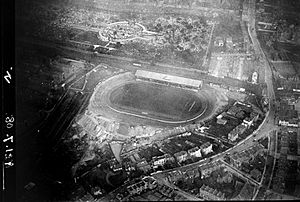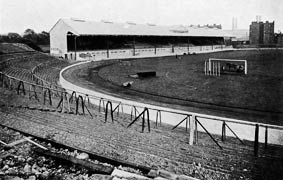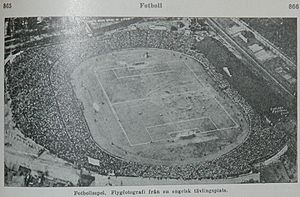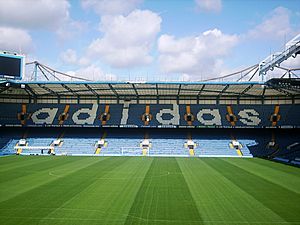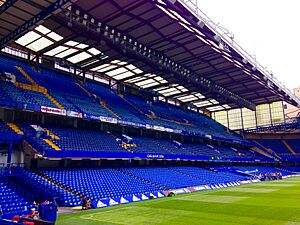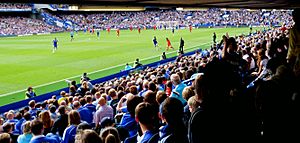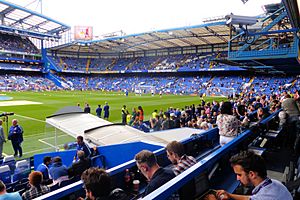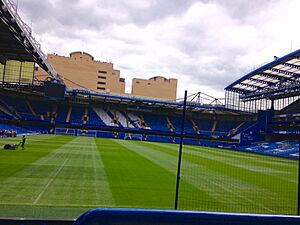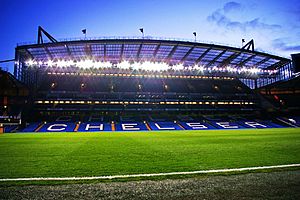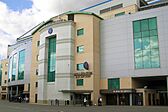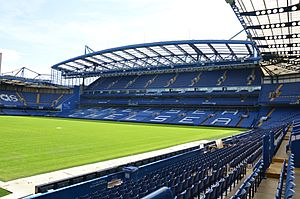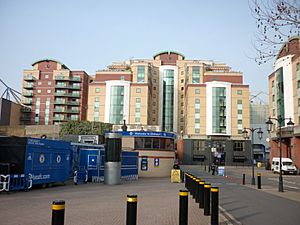Stamford Bridge (stadium) facts for kids
|
"The Bridge"
|
|

Aerial view of the stadium in 2023
|
|
| Full name | Stamford Bridge |
|---|---|
| Address | Fulham Road |
| Location | Fulham London, England SW6 1HS |
| Public transit | |
| Owner | Chelsea Pitch Owners |
| Operator | Chelsea |
| Executive suites | 51 |
| Capacity | 40,044 |
| Record attendance | 82,905 (Chelsea–Arsenal, 12 October 1935) |
| Field size | 112.97 by 74.03 yards (103.3 m × 67.7 m) |
| Surface | GrassMaster by Tarkett Sports |
| Construction | |
| Built | 1877 |
| Opened | 28 April 1877 |
| Renovated | 1904–1905, 1998 |
| Architect | Archibald Leitch (1887) |
| Tenants | |
| London Athletic Club (1877–1904) Chelsea (1905–present) Chelsea Women (2004–present) London Monarchs (NFL Europe) (1997) |
|
Stamford Bridge is a famous football stadium in Fulham, London. It is the home ground for Premier League club Chelsea.
With space for 40,044 fans, it is one of the largest football stadiums in England. The stadium first opened in 1877. It was used by the London Athletic Club until 1905. That's when a new owner, Gus Mears, started Chelsea Football Club. Chelsea has played all its home games there ever since. The stadium has changed a lot over the years. The most recent big changes happened in the 1990s. It was updated to be a modern stadium where everyone has a seat.
Stamford Bridge has also hosted other big football games. These include Charity Shield matches. Many other sports have been played there too. These include cricket, rugby union, speedway, and even American football. The most people ever to watch a game there was 82,905. This was for a match between Chelsea and Arsenal in 1935.
Contents
History of Stamford Bridge
How Stamford Bridge Got Its Name
The name "Stamford Bridge" comes from an old phrase. It means "the bridge at the sandy ford." A "ford" is a shallow place in a river or stream where you can cross. Old maps from the 1700s show a "Stanford Creek" nearby. This creek flowed into the River Thames. There were two bridges over this stream. One was on Fulham Road, which became Stamford Bridge. The other was on King's Road, now called Stanley Bridge. The current brick bridge was built between 1860 and 1862.
Early Days of the Stadium
Stamford Bridge first opened in 1877. It was mainly used for athletics by the London Athletic Club. In 1904, two brothers, Gus Mears and Joseph Mears, took over the lease. They wanted to host big professional football games there. They first offered it to Fulham Football Club, but Fulham said no. So, the Mears brothers decided to start their own team, Chelsea. This new club would play at Stamford Bridge.
A famous architect named Archibald Leitch designed the stadium. He also designed other well-known football grounds. When it was first built, Stamford Bridge was planned to hold about 100,000 people. This made it the second-largest ground in England at the time. The stadium had an athletics track around the football pitch. This meant fans were quite far from the action. There was one main stand for 5,000 people on the east side. The other sides were open terraces where thousands could stand.
In 1945, Stamford Bridge hosted a very special match. A team from the Soviet Union, FC Dynamo Moscow, played Chelsea. Over 100,000 people squeezed into the stadium to watch the game. Many fans even stood on the dog track and on top of the stands! The match ended in a 3-3 draw.
Challenges and Changes
In the 1970s, the club tried to rebuild Stamford Bridge. But the costs became too high, and there were strikes. Only the new East Stand was finished. The rest of the stadium stayed the same for many years. This caused big financial problems for Chelsea. The club struggled in the league and even faced relegation.
During this tough time, the land the stadium sat on was sold off. When Ken Bates bought Chelsea in 1982, he didn't own the ground. This led to a long legal battle. Eventually, Bates managed to buy the land back. This meant the club and the stadium were together again.
In the 1980s, after some fan trouble, Ken Bates put up an electric fence around the pitch. It was like the fences he used on his farm! However, the fence was never turned on. Local authorities stopped it for safety reasons, and it was soon taken down.
Modern Updates and Redevelopment
After the Hillsborough disaster in 1989, a report called the Taylor Report was published. It said that all top football stadiums in England had to have seats for everyone. This meant big changes for Stamford Bridge.
Throughout the 1990s, the stadium was rebuilt. The old running track was removed. Now, all the stands are close to the pitch. This helps make the crowd's noise louder and more exciting. The pitch and the club's name are now owned by Chelsea Pitch Owners (CPO). This group was set up to make sure the stadium can't be sold off by property developers again.
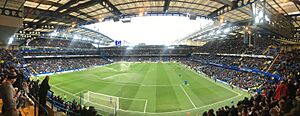
Other Events at Stamford Bridge
More Football Games
Stamford Bridge hosted the FA Cup Final three times, from 1920 to 1922. After that, the final moved to Wembley. The stadium has also held many FA Cup semi-finals and Charity Shield matches. The England team played there three times, with the last match in 1932.
In 2013, Stamford Bridge hosted the final of the 2012–13 UEFA Women's Champions League. On August 5, 2023, a charity match called Game4Ukraine was held there. It raised money to help Ukraine rebuild after the war. Stamford Bridge has also been a venue for Soccer Aid in 2019 and 2024. This is an annual charity match organized by famous people.
Chelsea Women's Team
Since the 2010s, Chelsea F.C. Women, the club's women's team, has played some of its games at Stamford Bridge. This includes important league matches and all their UEFA Women's Champions League games.
FA Cup Finals at Stamford Bridge
| Year | Attendance | Winner | Runner-up | |
|---|---|---|---|---|
| 1920 | 50,018 | Aston Villa | 1–0 | Huddersfield Town |
| 1921 | 72,805 | Tottenham Hotspur | 1–0 | Wolverhampton Wanderers |
| 1922 | 53,000 | Huddersfield Town | 1–0 | Preston North End |
International Football Matches
- 11 December 1909: England Amateurs 9–1 Netherlands
- 5 April 1913: England 1–0 Scotland
- 20 November 1929: England 6–0 Wales
- 7 December 1932: England 4–3 Austria
- 11 May 1946: England 4–1 Switzerland (Victory International)
- 25 March 2013: Brazil 1–1 Russia
Other Sports Hosted Here
Stamford Bridge has been home to many different sports. In 1905, it hosted a rugby union match. In 1908, it held a Rugby League international game. In 1914, a baseball match was played there. The stadium also hosted the 1924 Women's Olympiad. This was the first international event for women in track and field in the UK.
A speedway team raced at the stadium from 1929 to 1932. In 1980, it was used for a major day-night cricket match. Stamford Bridge even briefly hosted American football in 1997. The London Monarchs team played there.
Greyhound Racing at the Bridge
Greyhound racing came to Stamford Bridge in 1933. This meant the London Athletic Club had to leave. Greyhound racing was very popular and brought in a lot of money. However, the Greyhound Racing Association closed the track in 1968. An attempt to bring it back in 1976 failed.
Stadium Structure and Facilities
The Stamford Bridge pitch is surrounded by four covered stands. These are the Matthew Harding Stand (North), East Stand, The Shed End (South), and West Stand. Each stand has at least two levels. They were all built at different times as part of various expansion plans.
Matthew Harding Stand (North)
This stand is along the north side of the pitch. It was originally a small stand built in 1939. Later, it became open terraces for standing fans. In 1993, a new two-tier stand was built.
It is named after Matthew Harding. He was a Chelsea director who invested a lot in the club in the 1990s. Sadly, he died in a helicopter accident in 1996. His investment helped build this stand, which opened for the 1996-97 season. It's known for having a great atmosphere, especially in the lower part.
East Stand
When Stamford Bridge became a football ground in 1905, the East Stand was the only covered one. It had about 6,000 seats. In 1973, it was torn down to be rebuilt. The new stand opened in 1974. However, due to money problems, it was the only part of the stadium that was rebuilt at that time.
The East Stand still looks much like it did in 1973. It has three levels and has been updated a lot. This stand is the heart of the stadium. It houses the tunnel, team dugouts, dressing rooms, and press areas. The middle level has special facilities and executive suites. The upper level offers some of the best views of the pitch. Away fans used to sit in the lower tier. But since 2005, a family section has been there to boost team spirit. Away fans now sit in the Shed End.
Shed End (South)
The Shed End is on the south side of the pitch. A new terrace for standing fans was built here in 1930. Fans nicknamed it 'The Shed', and the club officially changed its name. It was a popular spot for the loudest and most dedicated supporters. In 1994, the terrace was demolished. This was because all stadiums had to have seats for safety reasons.
The new seated stand opened for the 1997-98 season. Like the Matthew Harding Stand, it's where many vocal fans gather. The view from the upper level is considered excellent. The Shed also has the club's museum and a memorial wall. Here, families can leave tributes to loved ones who were Chelsea fans. A part of the original wall from the old Shed End still stands. It's now decorated with lights and pictures of Chelsea legends. Since 2005, away supporters sit here. They get about 3,000 tickets. For domestic cup matches, away fans take up the whole stand.
The ashes of legendary player Peter Osgood were placed under the Shed End penalty spot in 2006.
West Stand
A seated West Stand was built in 1964-65. It replaced the old standing terraces. This stand was demolished in 1997 and replaced by the current West Stand. It has three levels and a row of executive boxes.
The lower level was finished in 1998. But problems with planning permission meant the stand wasn't fully completed until 2001. Building this stand almost caused another financial crisis for the club. It was saved by the help of Roman Abramovich.
- Statue of Peter Osgood outside Stamford Bridge, by Philip Jackson.
-
- A plaque on the side, written by official club historian Rick Glanvill, reads:
-
-
• Stamford bridge has many heroes but only one king • -
• Graceful technician • Nerveless striker • -
• Icon of the swinging sixties • -
• Adored by fans • Scorer of immortal cup final goals • -
• A big man for a golden age •
Now complete, the West Stand is the main "face" of the stadium. It's the first thing fans see when they enter from Fulham Road. The main entrance is surrounded by hospitality entrances. The stand also has the largest open area in the stadium, called the 'Great Hall'. It's used for many events, like the Chelsea Player of the Year ceremony.
The executive boxes, called the Millennium Suites, are named after former Chelsea players. These include Bobby Tambling, Steve Clarke, Ron Harris, Ted Drake, Peter Bonetti, and John Hollins.
In 2010, a nine-foot statue of Chelsea legend Peter Osgood was unveiled. It stands outside the West Stand. In 2020, a large mural by Solomon Souza was added to an outside wall of the West Stand. It's part of Chelsea's 'Say No to Antisemitism' campaign. The mural features footballers Julius Hirsch and Árpád Weisz, who died in the Holocaust. It also shows Ron Jones, a British prisoner of war known as the 'Goalkeeper of Auschwitz'.
The Pitch
The pitch at Stamford Bridge was built after the football club started in 1905. In June 2015, the pitch got major upgrades. This included new heating, drainage, and watering systems. A new hybrid grass pitch was also installed. This brought the pitch up to modern standards. The current pitch is about 103 meters long and 68 meters wide.
Chelsea Village and Surroundings
When Stamford Bridge was redeveloped, many extra features were added. These included two hotels, apartments, bars, restaurants, and the Chelsea Megastore. These were finished in 2001. The idea was for these facilities to bring in more money for the football club. However, they weren't as successful as hoped. Before Roman Abramovich bought the club in 2003, the debt from these projects was a big problem. The "Chelsea Village" brand was later dropped to focus on Chelsea as a football club.
Chelsea Museum
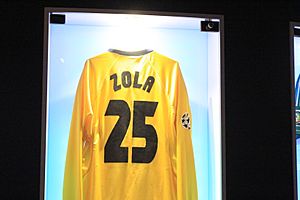
In 2005, a new club museum opened to celebrate Chelsea's 100th anniversary. It's called the Chelsea Museum or Centenary Museum. Visitors can learn about the club's history decade by decade. They can see old programs, jerseys, and other cool items.
In 2011, an even newer museum opened behind the Matthew Harding stand. It has improved and interactive exhibits. It is the largest football museum in London.
Chelsea Megastore
The club's official shop, called the Megastore, is at the stadium's south-west corner. It has two floors. The ground floor sells souvenirs and kids' items. The first floor offers clothing, including jerseys and jackets. There are also two smaller shops at other entrances.
Future Plans for Stamford Bridge
Former Chelsea owner Roman Abramovich had plans to rebuild Stamford Bridge. The goal was to increase its capacity to 55,000 to 60,000 seats. However, the stadium's location in a busy part of London makes this difficult. It's between a main road and two railway lines.
Looking for Other Locations
Other places were considered for a new stadium. These included Earls Court Exhibition Centre and Battersea Power Station. But under the rules of Chelsea Pitch Owners (CPO), the club would lose the name 'Chelsea Football Club' if it moved from Stamford Bridge. The club tried to buy back the land from CPO, but shareholders voted against it in 2011.
In 2012, Chelsea tried to buy Battersea Power Station to build a new stadium there. But their bid was not accepted.
Proposed Redevelopment Plan
In 2015, Chelsea announced plans to build a 60,000-seat stadium at Stamford Bridge. In 2017, the local council and the Mayor of London approved the rebuild. The plan was to demolish the entire Chelsea Village complex. A new stadium would be built with a new club shop, museum, bars, and restaurants.
The rebuild was expected to take 3-4 years. During this time, Chelsea would need another place to play home games. Wembley Stadium was considered as a temporary home.
Design of the New Stadium
The new stadium was designed by Swiss architects Herzog & de Meuron. They also designed the Allianz Arena in Munich. The design looked like a "cathedral of football." It featured 132 brick pillars and 132 steel pillars. These would extend over the roof. The stadium's unique shape was designed to fit the tight space. It also aimed to improve the match-day experience for fans. This included better views from all seats and easier access.
Legal Challenges and Suspension
In 2017, a family living near the stadium started legal action. They argued that the new building would block their natural light. The club tried to offer them compensation. In 2018, the local council supported the club. They planned to use their powers to help the project move forward.
However, on May 31, 2018, the club announced that the rebuild was on hold. They said it was due to the "unfavourable investment climate."
New Plans for the Future
In July 2022, it was reported that Chelsea's new owner, Todd Boehly, hired American architect Janet Marie Smith. She will oversee the renovation of the stadium. In July 2023, Chelsea reportedly agreed to buy most of the Sir Oswald Stoll Mansions site. This land is next to Stamford Bridge and could be used for future stadium redevelopment.
Stamford Bridge Statistics
Records
- Record attendance: 82,905 against Arsenal F.C. on October 12, 1935
- Lowest attendance: 3,000 against Lincoln City, Second Division, February 17, 1906 (During COVID: 2,000 against Leeds United, Premier League, December 5, 2020)
Average Attendances in the Premier League
| Season | Stadium capacity | Average attendance | % of capacity | Ranking within the Premier League |
|---|---|---|---|---|
| 2024–25 | 40,173 | 39,672 | 98.8% | 9th highest |
| 2023–24 | 40,343 | 39,700 | 98.4% | 9th highest |
| 2022–23 | 40,343 | 40,002 | 99.2% | 9th highest |
| 2021–22 | 40,343 | 36,424 | 90.3% | 10th highest |
| 2020–21 | 41,798 | 526 | 1.3% | 5th highest |
| 2019–20 | 41,798 | 32,023 | 76.6% | 8th highest |
| 2018–19 | 40,853 | 40,721 | 99.7% | 8th highest |
| 2017–18 | 41,631 | 41,282 | 99.2% | 8th highest |
| 2016–17 | 41,623 | 41,508 | 99.7% | 6th highest |
| 2015–16 | 41,798 | 41,500 | 99.2% | 7th highest |
| 2014–15 | 41,798 | 41,546 | 99.4% | 7th highest |
| 2013–14 | 41,798 | 41,482 | 99.3% | 6th highest |
| 2012–13 | 41,798 | 41,462 | 99.2% | 6th highest |
| 2011–12 | 42,449 | 41.478 | 97.7% | 6th highest |
| 2010–11 | 42,449 | 41,435 | 97.6% | 6th highest |
| 2009–10 | 42,055 | 41,423 | 98.5% | 5th highest |
| 2008–09 | 42,055 | 41.588 | 98.9% | 6th highest |
| 2007–08 | 42,055 | 41.397 | 97.7% | 7th highest |
| 2006–07 | 42,360 | 41.542 | 98.1% | 5th highest |
| 2005–06 | 42,360 | 41.902 | 98.9% | 5th highest |
| 2004–05 | 42,360 | 41,870 | 98.8% | 5th highest |
| 2003–04 | 42,360 | 41,235 | 97.3% | 5th highest |
| 2002–03 | 42,055 | 39,784 | 94.6% | 4th highest |
| 2001–02 | 42,055 | 39,030 | 92.8% | 6th highest |
| 2000–01 | 42,055 | 34,700 | 82.5% | 8th highest |
Getting to Stamford Bridge
Stamford Bridge is easy to reach by public transport. The closest London Underground station is Fulham Broadway. It has a special entrance for match days. This helps fans get in and out of the station easily. Parking cars in the area is very limited. So, using public transport is highly recommended.
| Service | Station/Stop | Line/Route | Walking distance from Stamford Bridge |
|---|---|---|---|
| London Buses |
Walham Green | 11, 14, 211, N11 | 200 yards (180 m) 2 mins |
| Fulham Broadway/ Fulham Town Hall |
28, 295, 306, 424, N28 | 0.2 miles (0.32 km) 5 mins | |
| London Underground |
Fulham Broadway | District line | 0.2 miles (0.32 km) 5 mins |
| Earl's Court | District line Piccadilly line |
1.1 miles (1.8 km) 27 mins | |
| National Rail London Overground |
West Brompton | London Overground | 0.8 miles (1.3 km) 20 mins |
| Imperial Wharf | 0.625 miles (1.006 km) 13 mins | ||
| London River Services |
Chelsea Harbour Pier | London River Services | 0.75 miles (1.21 km) 15 mins |
See also
 In Spanish: Stamford Bridge (estadio) para niños
In Spanish: Stamford Bridge (estadio) para niños
- Football in London
- Lists of stadiums


